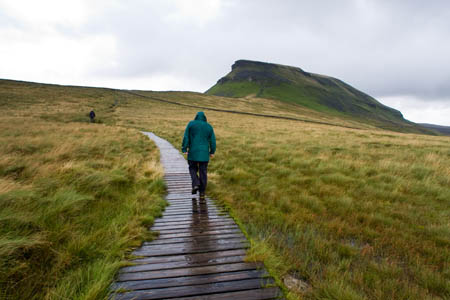
The Three Peaks Project has been set up to look after rights of way in this popular part of the Yorkshire Dales
Standing proud in the south-western corner of the Yorkshire Dales national park are three fells that, for centuries, have been the centre of mankind’s curiosity.
In fact, for some time, one of the peaks, Ingleborough, was mistakenly thought to be the highest mountain in England. It’s an easy mistake to make: its shapely escarpments form a commanding wall over the wide valley carrying the main Dales highway and, even from as far away as the Lancashire coast, its shape draws the eye.
More than 2,000 years ago, Iron Age settlers established a hill fort on Ingleborough’s broad summit plateau, and it must have proved one of the least popular postings for centurions posted to the far western fringe of the great Roman empire.
Together with its near neighbours Whernside and Pen-y-ghent, it has long drawn generations of settlers who have used the three mountains to serve their purposes: vantage points, military outposts, quarrying, farming, hunting and, latterly, outdoor recreation.
No-one knows who first had the idea of linking the three fells in one walk, but the 38km (24-mile) challenge of walking the Yorkshire Three Peaks and ascending their 1,600m (5,249 ft) has become one of the outdoor world’s most popular tests of strength and endurance.
And therein lies a problem. Not only do these three venerable mountains have to contend with the footsore and exhausted challenge walkers, but the peaks are climbed individually by many thousands of enthusiasts. When the last survey was carried out in the 1990s, Ingleborough had 120,000 visits each year, with Pen-y-ghent being walked by 80,000 and Whernside, the highest hill in Yorkshire, seeing 50,000 visits.
The popularity of the area earned it the dubious distinction in a 1986 study by the Institute for Terrestrial Ecology of the most severely eroded network of footpaths in the UK.
So what to do about this, one of the most popular areas of the Yorkshire Dales? The visitors aren’t going to go away, in fact figures suggest that, with the recession, weak pound and favourable seasonal weather forecast, more people than ever have holidayed in Britain, and the Dales’ rising car-park revenue supports the view that many of them have come district.
The Yorkshire Dales National Park Authority’s answer is to try to get walkers to put a little back for the enjoyment they take out. Hence the revival of the Three Peaks Project and the formation of a Friends group to provide cash and practical support for the 160 sq km of land encompassing the mountains.
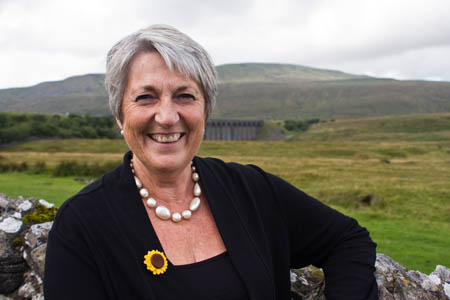
Angela Baker, with Whernside behind her
And who better to launch the Friends of the Three Peaks than the equivalent of Yorkshire royalty? Angela Baker has rubbed shoulders with Jerry Hall, Helen Mirren and Julie Walters. Angela persuaded her fellow members of Rylstone Women’s Institute to divest themselves of their twin sets and pose nude to raise cash for Leukaemia Research with the resultant calendar. Miss February had good reason to put cash into the coffers of the charity: her husband John had a terminal type of the disease. It was to be the start of a worldwide phenomenon that caught the imagination of many and has so far raised more than £2m for the cause.
But it wasn’t just the fact that Angela Baker lived and still lives in the Yorkshire Dales that made her the ideal candidate for membership number one of the Friends. Her late husband was assistant national park officer and had been instrumental in the setting up of the original Three Peaks Project in 1983.
Speaking to walkers, national park staff and supporters at the Station Inn, Ribblehead, she revealed that the first few pounds of the Leukaemia appeal had come from a sponsored Three Peaks walk.
Apologising for not joining the day’s walks on the fells – she is recovering from a knee operation – she told the gathering: “When John was ill about 25 of our friends came to him when he was in hospital and said: ‘We’d like to raise some money for Leukaemia Research and we’d like to walk the Three Peaks.’ John said: ‘Oh, I don’t know about that; I’ll have to think about it.’
“Anyway, he thought about it and the next day, he said, ‘Why not’. So they walked the Three Peaks and they raised the first £3,000 we ever raised. It went to Leukaemia Research and, of course, we’ve gone on with the calendar and everything else and it’s now over £2m that the Calendar Girls have raised for Leukaemia Research, but the first was that £3,000 that was raised by walking the Three Peaks. So he’d be thrilled to know that the work is still going on and it’s going to be there for future generations.”
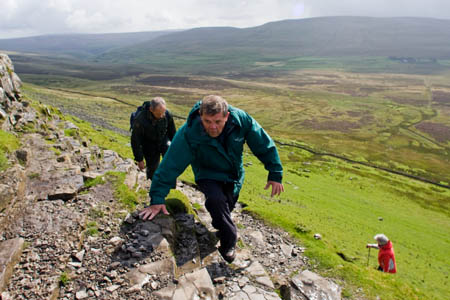
Authority chairman Carl Lis makes his ascent of Pen-y-ghent, under the watchful eye of Steve Hastie
Authority chairman Carl Lis explained why the Friends of the Three Peaks had been formed. He told grough: “We’ll always be grateful for how much finance we’ve had to do up the footpaths in the Three Peaks but, of course, that isn’t the end of it; then you’ve got the maintenance to think about and that’s what we’re aiming to try and finance now.
“I can understand to a certain extent how the major funders feel as though they’ve done their bit. So I think there’s a certain onus or expectation – why shouldn’t the users perhaps just give a little bit for the facility – it’s a fantastic facility.
“There are a variety of ideas we wish to develop to give users of the network the opportunity to support the area and the work of the authority. These include developing better links with sponsored-event organisers, developing merchandise to celebrate walking one, two, or even all three of the peaks.
“There is also another really important area we need to include in this initiative: that is, to acknowledge and include the many people who really love the area and share in the belief that the Three Peaks of Yorkshire are iconic. The authority believes that working together will enable us to conserve the landscape to allow future generations to enjoy this wonderful place of ours.
“The Friends of the Three Peaks has been created to provide a mechanism for organisations or individuals to commit to longer-term support for our work in the area through annual donations. We would encourage anyone who loves or has an affinity with the Three Peaks area to join the Friends to help us continue to protect this fragile landscape for the future.”
Three Peaks walkers can download from the authority’s site achievement certificates for walking one, two or all of the mountains. Local businesses will be encouraged to stock the new merchandise, including t-shirts, medals and other paraphernalia. All income from the new initiatives will be ‘ringfenced’ for use on the Three Peaks, Mr Lis says.
Charities which use the Three Peaks for fundraising challenge events are also being urged to put some money back into the area. The National Society for the Prevention of Cruelty to Children, Heart Research UK and Macmillan Cancer Care have all pledged to support the Three Peaks Project, as has the Three Peaks Race Association, which runs the annual fell race in which super-fit runners cover the course in less than three hours.
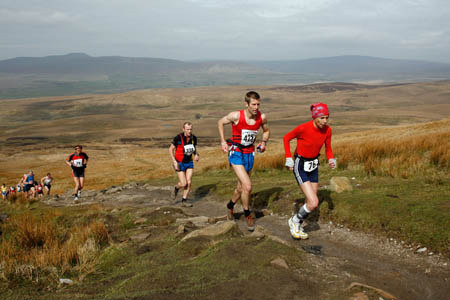
Women's winner Anna Pichrtova heads up Pen-y-ghent during the 2008 Three Peaks Race, which formed the World Long Distance Mountain Running Challenge
Steve Hastie, a 42-year-old area ranger who lives within sight of Ingleborough, has been appointed project manager for the Three Peaks. He has a wealth of experience in the area, having previously worked for the then English Nature on the Ingleborough nature reserves. He says his job is to look after rights of way in the area, administer open access land and liaise with all the bodies and users with a vested interest in the area.
He sees the project as a way of protecting the Three Peaks for generations to come. “I’d like to see a fully funded ranger, funded totally externally through either the Friends or donations or through sales of merchandise,” he told us after leading walkers up Pen-y-ghent.
“I’d like to see really good engagement with event organisers across the board. That’s definitely something to be worked on. We’re only in contact with a limited number at the moment. We’d like to work particularly with Horton Parish Council, because Horton bears the brunt of the sponsored Three Peaks charity events, and they’re very keen to be involved in that.
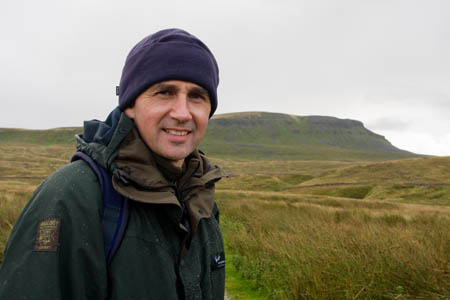
Three Peaks Project manager Steve Hastie on Pen-y-ghent
“It’s just creating the momentum that will keep it going, so we’ve got the businesses thinking about how they can work together to encourage people to stop in the area. Weekends are very busy; there’s probably not a lot of capacity, but in the week there is – we still have quiet times – and if they can work together, package some deals to encourage people to walk between the settlements over a few days; keep encouraging the public transport links, though we are tied by the resources we’ve got, but there are things there.
“The Three Peaks is one of the most visited areas of the national park for outdoor recreation.”
Up-to-date figures are being compiled. “We’ve got counters out on some of the routes – pressure-pad counters that record the number of people to a data logger that is then downloaded, and it works on an hourly basis so we’ll get quite interesting figures,” he explained. “That, probably with some observational work next spring and summer on the direction of flow of people, should give us some ideas of numbers.
“It’s a popular area. One of the advantages – or disadvantages – is that you’ve got very good road links. People don’t come by rail to do the Three Peaks. If people are just coming for the day, you can’t get here early enough to get round all three. You can come here for ten and do Whernside or Ingleborough and drop down to Horton, but to get here and do all three, we’re not there yet. If you come the day before, then for event organisers or accommodation providers, if we could get that as part of their sales material, you could come on the day before and then do the Three Peaks.”
Retired quarry manager Carl Lis, re-elected as authority chairman recently, undertook the walk to the summit of Pen-y-ghent. He freely admits he’s no great walker. “Today was the second time I’ve been up Pen-y-ghent,” he said. “I really feel a sense of achievement doing it. You can probably tell from my size I’m not a big walker, but it was brilliant. Last time I went up was with two parties of schoolkids to look at the work they did for the summit shelter. Last time I had to make a speech on top of Pen-y-ghent; this time at least I could wait till I got down, so I had more breath available to me. But it’s majestic.”
It took him more than 20 years to complete the challenge, he explained: “It took me 20 years to do the Three Peaks. It’s a bit of a standing joke. A few years ago I did a sponsored walk – doing Ingleborough and Whernside in the same day, but it was 20 years after that, in 2004, when I went up Pen-y-ghent with this group, so to my embarrassment, I was given a certificate at the authority meeting, when I was in the chair, saying that Carl Lis had completed the Three Peaks in 20 years, four days and so many hours and I’ve still got the certificate at home.”
Walkers, he said, are vital for the financial wellbeing of the Three Peaks area and the wider national park. “The economic benefit to the Yorkshire Dales of tourism is enormous.
“The foot-and-mouth closures in 2001 had the most enormous effect. Malham, for example: normally every weekend, you’d see hundreds of people there and they just weren’t there anymore. The place was just desolate. And I think it did make us realise – not only the Dales, I think we’d always had a feeling that it was there anyway – but the community was affected. In years gone by there was a feeling ‘Oh damn, visitors again’ but I think after that, there’s a realisation that we desperately need those people to keep those communities going – the shops and everything else.
“I think tourism is now the biggest source of economic benefit to the Dales. I think even our farmers who do a fantastic job, they would freely admit that. In fact, we’re trying to boost sales of local meat and local produce to visitors. We’re trying to do more and more of that and the foot and mouth [crisis] made, without question, not only the farmers but the entire population of the Dales just how important tourism was to us.”
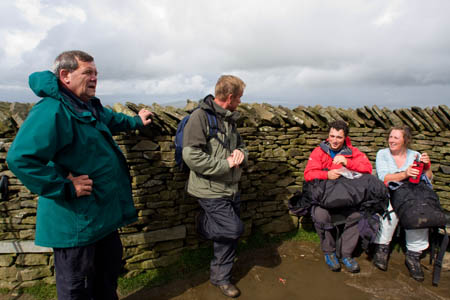
Three Peaks walkers meet their Waterloo on Pen-y-ghent summit while trying out those slate slabs
The Three Peaks can be surprising. Each has its own character: Ingleborough has, according to Steve Hastie, the best limestone pavement at any altitude in Europe. Whernside, the highest point in Yorkshire, actually has its trig point in Cumbria, just a metre or so on the ‘wrong’ side of the summit’s boundary wall. And Pen-y-ghent, the lowest of the three at 694m (2,277ft) has a little bit of unexpected history on its summit.
Steve explained: “When we were building the shelter on the summit, we wanted to put in slate seating.
“We had a bulk order of rectangular slates that we cut to size. This bulk order had come from a stone merchant and, when Waterloo Station was revamped for the Eurostar terminal, all the slate was pulled up and sold off and we ended up with about 100 tons of this which we eventually got into lots of stiles around the Dales but what we’ve done with the new shelter is, it’s cut into shape and it forms the seating on the summit and, on the underside of some of the seats, you can still read partially ‘mind the gap’ in painted letters.”
So now you know what’s happening if you see someone crouched on the summit looking skywards.
Details of the Three Peaks Project, along with its downloadable certificates which can be personalised, are on the Yorkshire Dales National Park Authority website.